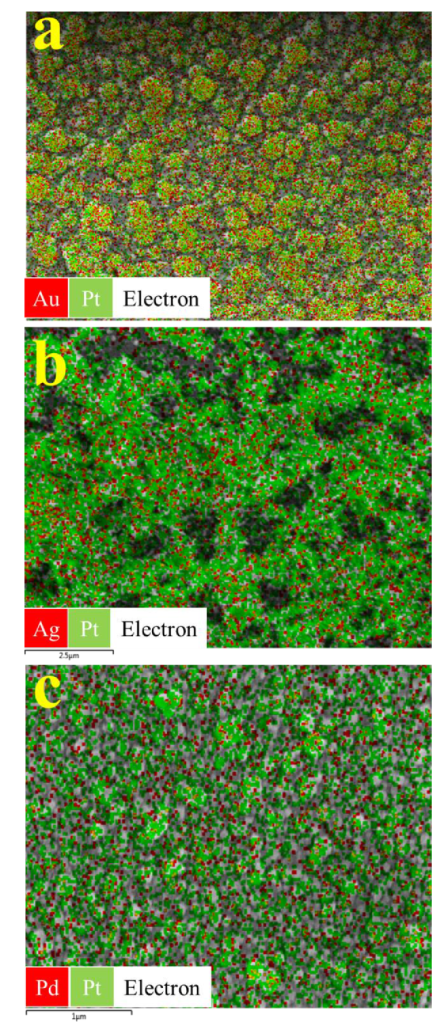Photoelectrical Dynamics Uplift in Perovskite Solar Cells by Atoms Thick 2D TiS2 Layer Passivation of TiO2 Nanograss Electron Transport Layer
Photoelectrical Dynamics Uplift in Perovskite Solar Cells by Atoms Thick 2D TiS2 Layer Passivation of TiO2 Nanograss Electron Transport Layer
Journal: Surfaces and Interfaces (click here for full paper)
Authors: Muhamad Adam Ramli, Elvy Rahmi Mawarnis, Marjoni Imamora Ali Umar, Mohd Yusri Abd Rahman, Vivi Fauzia, Muhammad Nurdin, Akrajas Ali Umar
Contact details for further info: akrajas@ukm.edu.my
Summary:
EDX elemental mapping spectra of bimetallic nanostructure samples namely (a) AuPt NFb (b) AgPt NFn and (c) PdPt FNC.
Charge transfer dynamic on the surface of a counter electrode (CE) of dye-sensitized solar cells (DSSC) during a photoactivation process relates to the physicochemical properties of the CE. In this paper, we investigated how the co-metal element in the Pt-based bimetallic fibrous nanocrystals (FNC) CE influences the charge transfer dynamic of the dye-sensitized solar cell (DSSC) devices. We discovered that the interfacial charge transfer resistance decreases dramatically in bimetallic CEs if compared with the pristine Pt. For example, it decreases more than 5 times in the AuPt FNC and more than 4 times lower in the AgPt and PdPt FNC CEs. This phenomenon then induced an enhanced carrier diffusion in the device that is reflected by the decrease in the carrier diffusion resistance and the improvement of the carrier lifetime in the device using bimetallic CEs. The DSSCs using the champion CEs, that is AuPt, can produce a short circuit current (Jsc), open-circuit voltage (Voc), and fill factor (FF) as high as 10.63 mAcm−2, 1.00 V, and 0.43, respectively, which correspond to a power conversion efficiency (PCE) of 4.60%. This PCE is approximately 3.5 times higher if compared with the DSSC using the pristine Pt CE. The enhancement of the surface physicochemical properties of the CE due to the bimetallization process is assumed as the key factor for the performance enhancement, the facts that are verified by the X-ray photoelectron spectroscopy and the electrochemical properties analysis results. The synthesis and the device characterization are discussed in detail.


